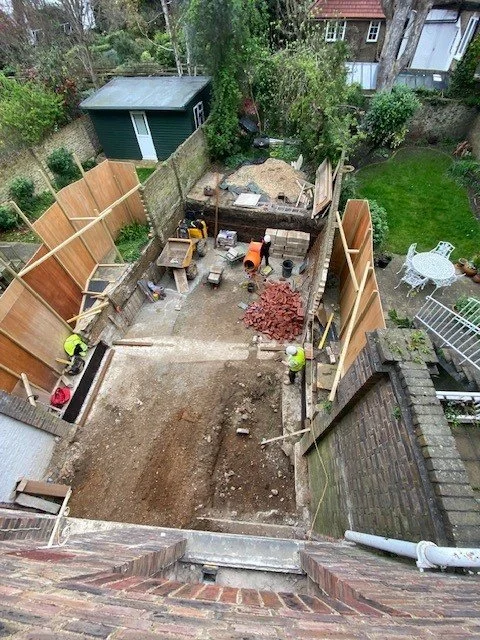
Neighbourly Building
Building Work and the Party Wall Act
Why the Party Wall Act Matters in Your Build
If your project involves a shared wall or sits close to your neighbour’s boundary, the Party Wall Act could apply. This legislation isn’t about stopping you building, it’s about setting fair rules so everyone is informed, protected, and clear on how works will proceed. Knowing what is required, and when to act, keeps your project moving smoothly and prevents avoidable disputes.
The Party Wall Process Explained
A party wall is simply a wall or structure shared between properties, or built directly on the boundary line. The Party Wall Act was introduced to avoid conflict and confusion whenever building work affects these walls, adjacent foundations, or nearby structures.
It sets out a framework that:
Informs neighbours about intended works.
Provides options to consent, add conditions, or dissent.
Safeguards structures by involving impartial surveyors when required.
Resolves disputes in a fair and legally binding way.
Handled early and openly, the Party Wall process becomes just another part of your pre-construction journey. It isn’t about giving neighbours the power to veto your plans, it’s about giving clarity and structure so your project can progress with confidence.
Quick Answers
When do I need to send a Party Wall Notice?
If you’re carrying out works on or near a shared wall, boundary, or neighbour’s foundations, from loft conversions and extensions to basements, a formal notice may be required.
Can my neighbour stop me from building?
No. Neighbours can consent, set conditions, or dissent, but provided you follow the Act’s procedures and secure any necessary Awards, they cannot prevent works from going ahead
Do I always need a surveyor?
Not always. If your neighbour consents, the process is straightforward. If they dissent or don’t reply within 14 days, surveyors step in to agree a Party Wall Award. Early planning helps you know if, when, and how to appoint one.
How the Party Wall Process fits into your build
The Party Wall process isn’t something every project needs, but knowing whether it applies, and when to begin, is essential. The Act only comes into play if your works affect a shared wall, boundary, or foundations close to your neighbour’s property.
Some projects can move forward with no notices at all, while others require careful sequencing. The key is spotting early whether the Act applies, so you can build it into your overall pre-construction plan rather than letting it become a last-minute delay.
The first step is often a conversation. Speaking with neighbours before formal notices are served sets the right tone and can prevent misunderstandings. From there, the Act sets out a clear framework: the right notice is issued, neighbours have 14 days to respond, and their choice, consent, conditions, or dissent, determines the next steps. If surveyors are needed, they act impartially to balance interests and issue an Award that allows the works to proceed.
Timings matter. For simple projects, an Award can sometimes be issued within weeks; for more complex works, the process may take months. That’s why understanding when to serve notices, and how it ties into the rest of your project, makes such a difference. Inside Plan It, the Party Wall process is woven into your Pre-Construction Roadmap alongside design, consents, and procurement, so you can see exactly where it fits. Not every project will need a notice, but every homeowner benefits from knowing how to check, when to act, and where to turn for trusted surveyor support if it’s required.
Handled this way, the Party Wall process becomes part of your project journey, a safeguard rather than a stumbling block.
Why This Step Matters
Overlooking the Party Wall process is one of the quickest ways to create delays, disputes, and unnecessary costs. Notices served too late, or not at all, can put you in breach of the Act and force a stop to works. Even simple misunderstandings with neighbours can escalate if the correct procedures aren’t followed.
By building the Party Wall process into your roadmap from the outset, you avoid last-minute panic and keep your project legally protected. You’ll know whether notices are required, when to serve them, and how long the process is likely to take, all before builders are on site. This clarity allows you to maintain neighbourly goodwill and avoid being caught off guard.
Without it, you risk strained relationships, lost time, and added expense just when you should be ready to build.
Build with Confidence, Not Conflict
The Plan It pathway shows you how to identify if the Party Wall Act applies, when to act, and how to integrate the process into your Pre-Construction Roadmap, and where to find surveyor support if it becomes necessary.
Guided Pathways
-

Plan It
Plan It equips you with the knowledge, tools, and structured processes to confidently design, budget, and prepare your homebuilding project, ensuring a smooth and well-managed build.
-

Build It
Build It equips you with the expertise, guidance, and step-by-step processes to manage your construction project effectively, ensuring quality, cost control, and timely completion.
-

Certify It
Certify It equips you with the knowledge and processes to navigate final inspections, compliance, and certification, ensuring your project is completed with the documentation needed to validate your investment.





